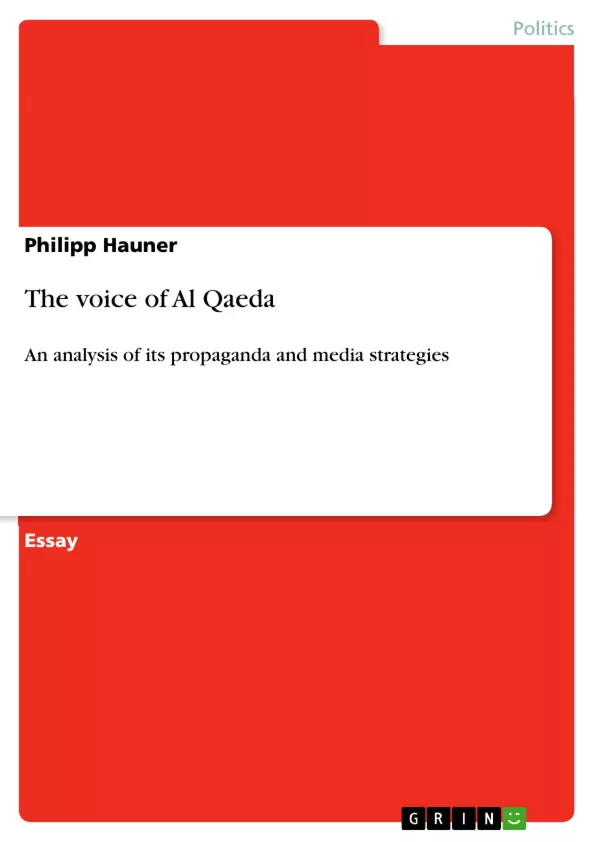Speaking about terrorism in a scientific way, it is inevitable to take into account the relationship between media and terrorism. As this essay wants to outline the main characteristics of how and why the transnational terror network Al Qaeda is designing its public appearance, a brief introduction into the general discussion on terrorism and the media is given in the following.
The relationship between these two actors is often described as symbiotic or even one of “considerable mutual benefit.” On the one hand the mass media can profit from the coverage of terrorist attacks because they can increase their circulation or viewing figures. On the other hand, terrorists achieve the wanted attention, convey the propaganda of the deed and inflict great fear on their target group(s). If successful, they can even mobilize wider support and influence political decisions of their enemies, in the way that they contribute to the desired escalation-spiral. This connection probably led former British Prime Minister Margaret Thatcher to the famous words ‘oxygen of publicity’: A comparison, which illustrates the absolute need for terrorists to be covered in the media; for them it is as important as the air they breathe. Some theorists are sharing the opinion, that terrorism only becomes what it is through the media coverage: “Without the media aspect, terrorism remains one more cause of death, one of many, and not necessarily the most important or most dangerous one.” But despite the recognition of the so-called amplification effect, censorship is neither desirable nor realizable in open western societies. So it is often said, that we are here caught in a dilemma and the only thing, media can do is to weigh carefully, which incidents to show and to what extent. Furthermore they should regard it as their self-evident duty to foster the awareness of civilians and to provide a forum for reasonable discussion.
This essay shall portray one of the most prominent and surely most actual terrorist groups: Al Qaeda. It will give an overview about its media strategies, but as well will not forget the propaganda management, which tries to efficiently recruit new members and foster support for the group. At first, there will be given a brief oversight and explanation of the ‘metamorphosis of war’, a central condition for Al Qaeda’s engagement in propaganda, and how the terrorist group correlates with it.
Inhaltsverzeichnis (Table of Contents)
- A) Introduction: The difficult relationship between media and terrorism
- B) The voice of Al Qaeda: An analysis of its propaganda and media strategies
- 1. Conditions for Al Qaeda’s engagement in propaganda
- 1.1. The metamorphosis of war
- 1.2. The importance of communication, in particular propaganda for Al Qaeda
- 2. The evolution of Al Qaeda propaganda
- 2.1. Propaganda before 9/11
- 2.2. The change in propaganda strategies after 9/11
- 3. Al Qaeda and Al Jazeera
- 3.1. Presentation of ‘Arab’s CNN’
- 3.2. Osama bin Laden on the screen
- 3.3. The Western reaction
- 3.4. Assessment of the Al Jazeera case study
- 4. Internet on TV: The terror threat in German channels
- 1. Conditions for Al Qaeda’s engagement in propaganda
Zielsetzung und Themenschwerpunkte (Objectives and Key Themes)
This essay aims to analyze Al Qaeda's propaganda and media strategies, examining how the group utilizes these tools to achieve its objectives. It explores the relationship between media and terrorism more broadly, focusing specifically on Al Qaeda's adaptation to modern communication technologies.
- The symbiotic relationship between media and terrorism.
- Al Qaeda's evolution of propaganda strategies before and after 9/11.
- Al Qaeda's use of Al Jazeera as a propaganda platform.
- The role of the internet in disseminating Al Qaeda's message.
- The challenges of countering Al Qaeda's propaganda.
Zusammenfassung der Kapitel (Chapter Summaries)
A) Introduction: This section introduces the complex and often symbiotic relationship between media and terrorism, highlighting the mutual benefits both actors can derive from this interaction. It sets the stage for the analysis of Al Qaeda’s specific media strategies.
B) The voice of Al Qaeda: This section delves into Al Qaeda’s propaganda and media strategies. It examines the conditions that fostered Al Qaeda’s engagement in propaganda, including the "metamorphosis of war" and the crucial role of communication within the network. The evolution of Al Qaeda's propaganda techniques from its early days to the post-9/11 era is discussed, highlighting the increased use of the internet and the strategic exploitation of events for propaganda purposes. The case study of Al Jazeera and Al Qaeda's use of the network is also analyzed, along with the Western reaction to Al Qaeda’s media presence. Finally, it explores the use of the internet by terrorist groups to reach audiences via television broadcasts.
Schlüsselwörter (Keywords)
Al Qaeda, propaganda, media strategies, terrorism, communication, internet, Al Jazeera, counter-propaganda, global Jihad, netwar, media coverage, franchise terrorism.
- Arbeit zitieren
- Philipp Hauner (Autor:in), 2007, The voice of Al Qaeda, München, GRIN Verlag, https://www.grin.com/document/123603



